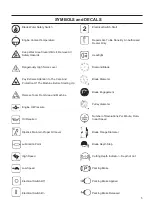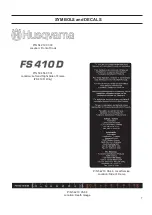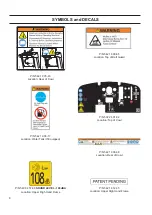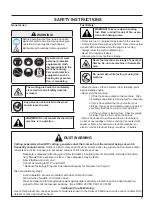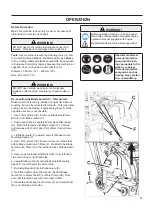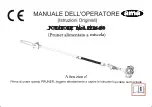
0
General Information
Carbon monoxide (CO) has the distinction of being one of the few commonly encountered industrial gasses that is
both highly toxic (poison) and odorless. When inhaled, CO acts as a chemical asphyxiant by preferentially combin-
ing with hemoglobin in the blood stream. As a result, the hemoglobin is not able to transport its normal amount of
oxygen, which results in under-oxygenation of tissues. Symptoms of low-level CO exposure include headaches,
dizziness, confusion, and nausea.
However, loss of consciousness, permanent injury and death may result
from continued or more intense exposure.
Because of the health hazards associated with CO inhalation, the Oc-
cupational Safety and Health Administration (OSHA) have imposed personal exposure limits. The OSHA exposure
limits, which are specified in the 29 CFR 1910.1000 (1998 Revision), allow for a 200 PPM Ceiling Limit and a TWA
of PPM per 8-hour shift/0-hr workweek. It is strongly recommended that the OSHA 9 CFR 90.000 (Code
of Federal Regulations) be consulted for more information on exposure limits for various hazardous materials. If CO
Poisoning is suspected immediately remove the victim to fresh air and obtain emergency medical attention.
Proper Ventilation:
THIS SAW IS SHIPPED FROM THE FACTORY
WITHOUT A CATALYTIC CONVERTER.
It is important to be aware
that saws with catalytic converters reduce CO and hydrocarbon (HC) emissions. The exhaust still contains CO. If the
workspace is too confined or under-ventilated, CO may accumulate until it eventually exceeds OSHA limits. When
this happens, action must be taken to remove workers from areas of high concentration. Operators and work area
supervisors should take precautions to insure adequate ventilation of the workspace at all times. Carbon monoxide
detection monitors should be used to determine that adequate ventilation exists.
WARNING
POISON EXHAUST GAS
THIS SAW IS SHIPPED FROM THE FACTORY
WITHOUT A CATALYTIC CONVERTER.
THE ENGINE PRODUCES CARBON MONOXIDE EXHAUST EMISSIONS AND IS
NOT SAFE
FOR USE IN
ENCLOSED AREAS. USE OF A CATALYTIC CONVERTER REDUCES THE CARBON MONOXIDE EXHAUST
EMISSIONS, BUT STILL IS
NOT SAFE
FOR USE IN ENCLOSED AREAS.
USE ONLY IN WELL-VENTILATED AREAS. WORKSITE AIR QUALITY MUST COMPLY WITH
OSHA 9 CFR 90.000 PER TABLE Z-, LIMITS FOR AIR CONTAMINANTS.
MONITOR WORKSPACE AIR QUALITY TO INSURE COMPLIANCE. FAILURE TO COMPLY WILL RESULT IN
DANGER TO LIFE AND CAUSE PERMANENT INJURY OR DEATH.
WARNING
HEARING HAZARD
DURING NORMAL USE OF THIS MACHINE, OPERATOR MAY BE EXPOSED TO A NOISE
LEVEL EQUAL TO
85 dB (A)
OR GREATER. TEMPORARY AND/OR PERMANENT DAMAGE TO HEARING
MAY RESULT. HEARING PROTECTION REQUIRED.
SAFETY INSTRUCTIONS
Summary of Contents for FS 410 D
Page 2: ... ...
Page 13: ...13 NOTES ...
Page 30: ...30 WIRING DIAGRAM See Engine Operation Manual ...
Page 31: ......
Page 36: ...36 ...
Page 47: ...47 NOTAS ...
Page 64: ...64 DIAGRAMA DE CABLEADO Consulte el manual de operación del motor ...
Page 65: ......
Page 70: ...70 ...
Page 81: ...81 NOTES ...
Page 98: ...98 SCHÉMA DE CÂBLAGE Voir le manuel d utilisation du moteur ...
Page 99: ......
Page 104: ... ...
Page 115: ...13 NOTIZEN ...
Page 132: ...30 SCHALTBILD Siehe Betriebsanleitung des Motors ...
Page 133: ......
Page 138: ...36 ...
Page 149: ...47 AANTEKENINGEN ...
Page 166: ...64 BEDRADINGDIAGRAM Zie bedieningshandleiding van motor ...
Page 167: ......
Page 172: ...70 ...
Page 183: ...81 ANNOTAZIONI ...
Page 200: ...98 SCHEMA CIRCUITALE Consultare il manuale del motore ...
Page 201: ......
Page 206: ...104 ...
Page 218: ...116 NOTAS ...
Page 235: ...133 DIAGRAMA DAS LIGAÇÕES Consultar o manual de funcionamento do motor ...
Page 236: ......
Page 251: ...149 ANTECKNINGAR ...
Page 268: ...166 KOPPLINGSCHEMA Se motorns bruksanvisning ...
Page 269: ......
Page 274: ......
Page 275: ......





